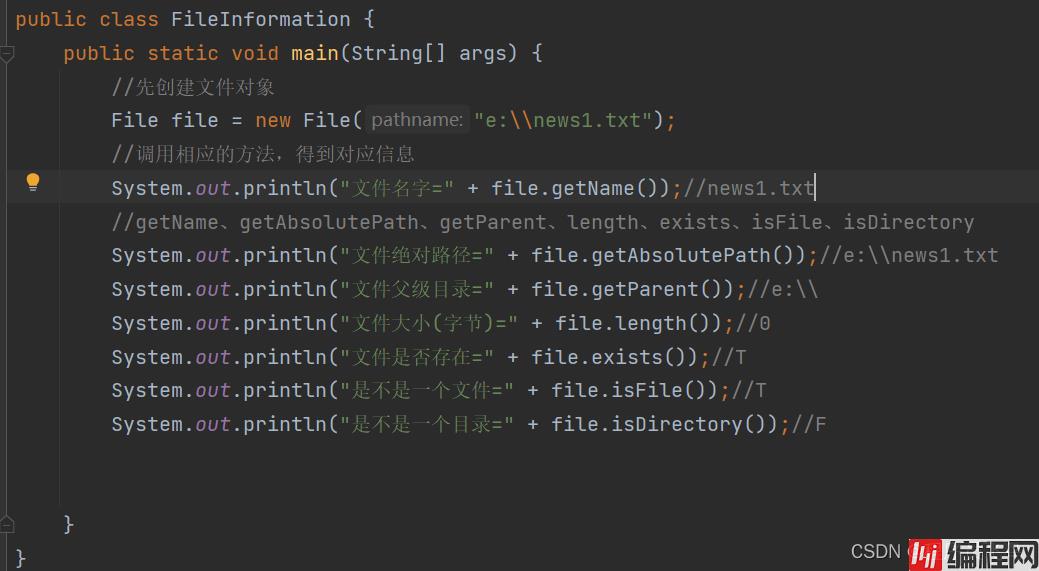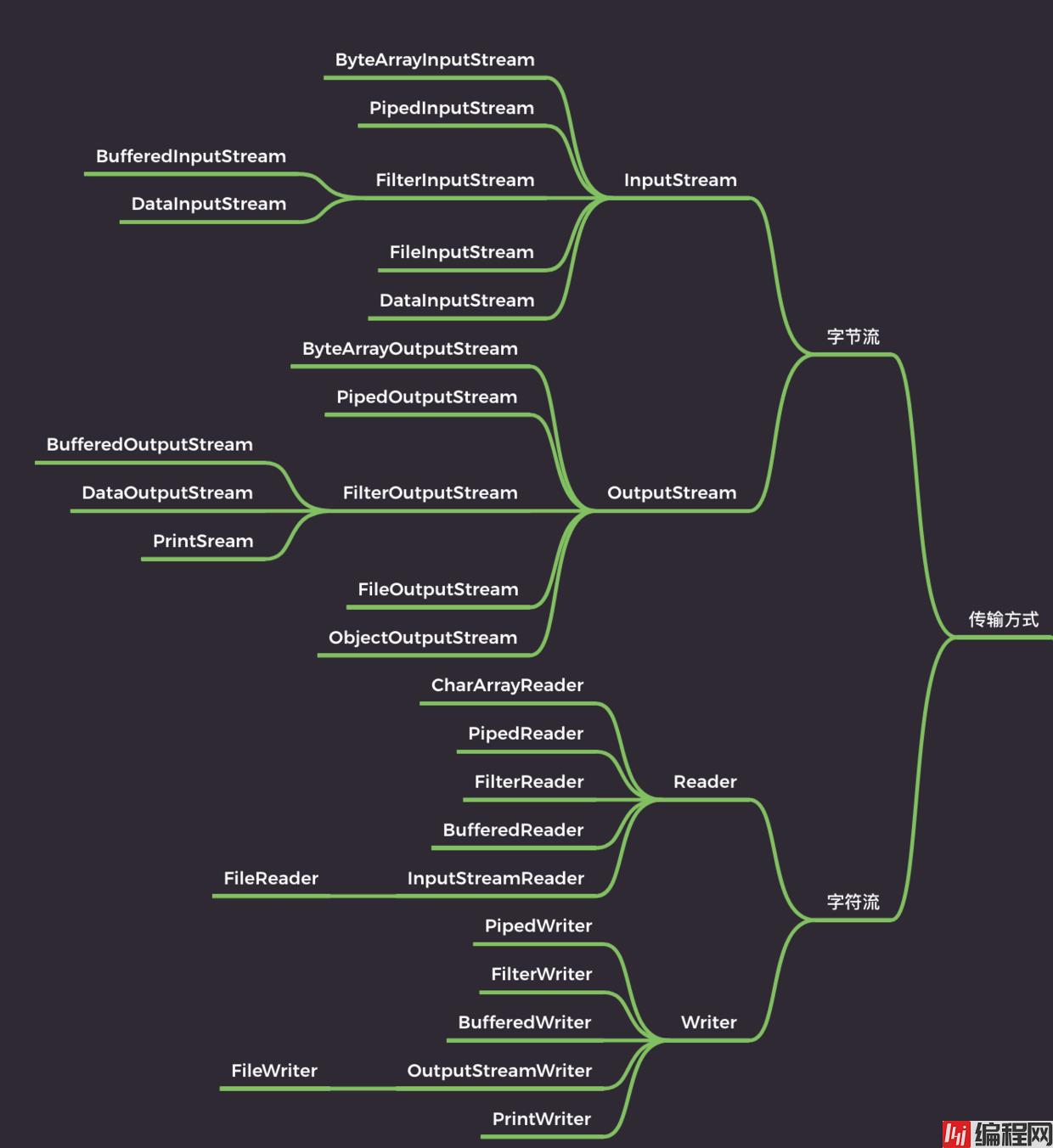Python 官方文档:入门教程 => 点击学习
目录一、什么是io流二、常用的文件操作三、获取文件的相关信息四、目录的操作和文件删除五、IO流体系图-常用的类六、FileInputStream常用方法七、FileOutputStr
输入流和输出流。
学习目标:创建文件对象相关构造器和方法
new File(String pathname)//根据路径构建一个File对象
new File(File parent,String child)//根据父目录文件+子路径构建
new File(String parent,String child)//根据父目录+子路径构建
学习任务:在e盘下,创建文件news1.txt、news2.txt、news3.txt用三种不同方式创建。
三种方式简单看一下就行,后面会经常遇到。
new File(String pathname)//根据路径构建一个File对象
package com.file;
import java.io.*;
public class FileCreate {
public static void main(String[] args) {
//方式 1 new File(String pathname)
String filePath = "e:\\news1.txt";
File file = new File(filePath);
try {
//创建新文件
file.createNewFile();
System.out.println("文件创建成功");
} catch (IOException e) {
e.printStackTrace();
}
}
}new File(File parent,String child)//根据父目录文件+子路径构建
package com.file;
import java.io.*;
public class FileCreate {
public static void main(String[] args) {
//方式 2 new File(File parent,String child) //根据父目录文件+子路径构建
//e:\\news2.txt
File parentFile = new File("e:\\");
String fileName = "news2.txt";
//这里的 file 对象,在 java 程序中,只是一个对象
//只有执行了 createNewFile 方法,才会真正的,在磁盘创建该文件
File file = new File(parentFile, fileName);
try {
file.createNewFile();
System.out.println("创建成功~");
} catch (IOException e) {
e.printStackTrace();
}
}
}new File(String parent,String child)//根据父目录+子路径构建
package com.file;
import java.io.*;
public class FileCreate {
public static void main(String[] args) {
//方式 3 new File(String parent,String child) //根据父目录+子路径构建
String parentPath = "e:\\";
String fileName = "news3.txt";
File file = new File(parentPath, fileName);
try {
file.createNewFile();
System.out.println("创建成功~");
} catch (IOException e) {
e.printStackTrace();
}
}
}getName、getAbsolutePath、getParent、length、exists、isFile、isDirectory
学习任务:获取文件的大小、文件名、路径、父File,是文件还是目录(目录本质也是文件,一种特殊的文件),是否存在

学习任务:
package com.collection;
import java.io.File;
public class Delete {
public static void main(String[] args) {
String filePath="e:\\news1.txt";
File file=new File(filePath);
if(file.exists()){
file.delete();
}else {
System.out.println("否则文件不存在~");
}
}
}package com.collection;
import java.io.File;
public class Delete {
public static void main(String[] args) {
String filePath="e:\\demo02";
File file=new File(filePath);
if(file.exists()){
if(file.delete()){
System.out.println(filePath+"删除成功");
}
else{
System.out.println(filePath+"删除失败");
}
}else {
System.out.println("否则目录不存在~");
}
}
}package com.collection;
import java.io.*;
public class Delete {
public static void main(String[] args) {
String directoryPath="e:\\demo\\a\\b\\c";
File file=new File(directoryPath);
if(file.exists()) {
System.out.println(directoryPath + "存在。。");
}
else {
if (file.mkdirs()){
System.out.println(directoryPath+"创建成功。。");
}else{
System.out.println(directoryPath+"创建失败。。");
}
}
}
}按操作数据单位不同分为:字节流(8bit)二进制文件,字符流(按字符)文本文件
按数据流的流向不同分为:输入流,输出流
按流的角色的不同分为:节点流,处理流/包装流
字节流:InputStream,OutputStream
字符流:Reader,Writer

学习任务:请使用 FileInputStream 读取 hello.txt 文件,并将文件内容显示
先在e盘下创建hello.txt输入内容hello world
package com.FileInputStream;
import java.io.FileInputStream;
import java.io.IOException;
//字节流文件的输入程序
public class FileInputStream_ {
public static void main(String[] args) {
String filePath="e:\\hello.txt";
int readData=0;
FileInputStream fileInputStream=null;
try {
//创建 FileInputStream 对象,用于读取文件
fileInputStream=new FileInputStream(filePath);
//从该输入流读取一个字节的数据。 如果没有输入可用,此方法将阻止。
//如果返回-1 , 表示读取完毕
while ((readData = fileInputStream.read()) != -1) {
System.out.print((char)readData);//转成 char 显示
}
} catch (IOException e) {
e.printStackTrace();
}finally {
try {
//关闭文件流
fileInputStream.close();
} catch (IOException e) {
e.printStackTrace();
}
}
}
}学习任务:请使用 FileOutputStream 在 abc.txt 文件,中写入 “hello,world”. 如果文件不存在,会创建 文件(注意:前提是目录已经存在.)
package com.hspedu.outputstream_;
import java.io.*;
public class FileOutputStream01 {
public static void main(String[] args) {
String filePath = "D:\\abc.txt";
FileOutputStream fileOutputStream = null;
try {
//得到 FileOutputStream 对象 对象
//1. new FileOutputStream(filePath) 创建方式,当写入内容是,会覆盖原来的内容
// 2. new FileOutputStream(filePath, true) 创建方式,当写入内容是,是追加到文件后面
fileOutputStream = new FileOutputStream(filePath);
//写入一个字节
//fileOutputStream.write('H');
//写入字符串
String str = "hello,world!";
//str.getBytes() 可以把 字符串-> 字节数组
//fileOutputStream.write(str.getBytes());
fileOutputStream.write(str.getBytes(), 0, 3);
} catch (IOException e) {
e.printStackTrace();
} finally {
try {
fileOutputStream.close();
} catch (IOException e) {
e.printStackTrace();
}
}
}
}学习任务:编程完成图片/音乐 的拷贝
package com.hspedu.outputstream_;
import java.io.*;
public class FileCopy {
public static void main(String[] args) {
String srcFilePath="e:\\9030.jpg";
String destFilePath="e:\\9031.jpg";
FileInputStream fileInputStream=null;
FileOutputStream fileOutputStream=null;
try {
fileInputStream=new FileInputStream(srcFilePath);
fileOutputStream=new FileOutputStream(destFilePath);
//定义一个字节数组,提高读取效果
byte[] buf=new byte[1024];
int readLen=0;
while ((readLen=fileInputStream.read(buf))!=-1){
fileOutputStream.write(buf,0,readLen);
}
System.out.println("拷贝成功!");
} catch (IOException e) {
e.printStackTrace();
}finally {
try{
if(fileInputStream!=null){
fileInputStream.close();
}
if(fileOutputStream!=null){
fileInputStream.close();
}
}catch (IOException e){
e.printStackTrace();
}
}
}
}学习任务:使用 FileReader 从 story.txt ,这一步先在story.txt存在数据,然后在端口输出数据显示出来
package com.reader_;
import java.io.FileReader;
import java.io.IOException;
public class ReadFile01 {
public static void main(String[] args) {
String filePath="e:\\story.txt";
FileReader fileReader=null;
int data=0;
//创建FileReader对象
try{
fileReader =new FileReader(filePath);
//循环读取 使用 read, 单个字符读取
while((data=fileReader.read())!=-1){
//data数值为整数型,强制转换为字符
System.out.print((char)data);
}
}catch(
IOException e){
e.printStackTrace();
}finally {
try{
if(fileReader!=null){
//关闭文件流
fileReader.close();
}
}catch(IOException e){
e.printStackTrace();
}
}
}
}学习任务:字符数组读取文件
package com.reader_;
import java.io.FileReader;
import java.io.IOException;
public class ReadFile02 {
public static void main(String[] args) {
String filePath="e:\\story.txt";
FileReader fileReader=null;
int readLen=0;
char[] buf=new char[8];
//创建FileReader对象
try{
fileReader =new FileReader(filePath);
//循环读取 使用 read(buf), 返回的是实际读取到的字符数
//如果返回-1, 说明到文件结束
while((readLen=fileReader.read(buf))!=-1){
System.out.print(new String(buf,0,readLen));
}
}catch(
IOException e){
e.printStackTrace();
}finally {
try{
if(fileReader!=null){
fileReader.close();
}
}catch(IOException e){
e.printStackTrace();
}
}
}
}学习任务:使用 FileWriter 将 “风雨之后,定见彩虹” 写入到 note.txt 文件中
package com.hspedu.writer_;
import java.io.FileWriter;
import java.io.IOException;
public class FileWriter_ {
public static void main(String[] args) {
String filePath="e:\\noth.txt";
FileWriter fileWriter=null;
char[] chars={'a','b','c'};
try {
fileWriter = new FileWriter(filePath);
//3) write(int):写入单个字符
fileWriter.write('H');
// 4) write(char[]):写入指定数组
fileWriter.write(chars);
// 5) write(char[],off,len):写入指定数组的指定部分
fileWriter.write("程序员飞鸟".toCharArray(), 0, 3);
// 6) write(string):写入整个字符串
fileWriter.write(" 你好广州");
fileWriter.write("风雨之后,定见彩虹");
// 7) write(string,off,len):写入字符串的指定部分
fileWriter.write("上海天津", 0, 2);
} catch (IOException e) {
e.printStackTrace();
}finally{
try {
//对应 FileWriter , 一定要关闭流,或者 flush 才能真正的把数据写入文件里面
fileWriter.flush();//关闭文件流
} catch (IOException e) {
e.printStackTrace();
}
}
System.out.println("程序结束~");
}
}到此这篇关于Java细数IO流基础到方法使用的文章就介绍到这了,更多相关Java IO流内容请搜索编程网以前的文章或继续浏览下面的相关文章希望大家以后多多支持编程网!
--结束END--
本文标题: Java细数IO流底层原理到方法使用
本文链接: https://www.lsjlt.com/news/148947.html(转载时请注明来源链接)
有问题或投稿请发送至: 邮箱/279061341@qq.com QQ/279061341
下载Word文档到电脑,方便收藏和打印~
2024-03-01
2024-03-01
2024-03-01
2024-02-29
2024-02-29
2024-02-29
2024-02-29
2024-02-29
2024-02-29
2024-02-29
回答
回答
回答
回答
回答
回答
回答
回答
回答
回答
0